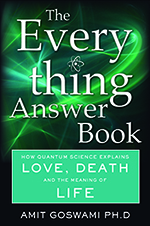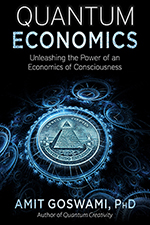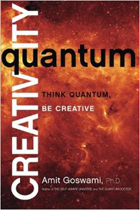Quantum Optimism
By Amit Goswami, Ph.D.
The metaphysics on which we base our perception of the world today is pessimistic. The metaphysics of scientific materialism that is now the foundation of all our sciences and social systems recognizes only the existence of matter, which necessarily limits our choices and therefore our ability to solve the planetary crises facing the human race. The material world provides only one kind of experience: sensing. The human faculties of feeling, thinking, and intuiting are left out of this scientific model. (As identified by Carl Jung, people exhibit four psychological preferences in perceiving the world: sensing, feeling, thinking, and intuiting.)
Quantum physics, the new science, makes it possible to recognize that there are four universes for our experiences: the physical, the vital, the mental, and the supra mental. The physical, we sense. The vital, we feel. The mental, we think. The supra mental, we intuit. In this way, Quantum physics helps us put together the entire human experience within one science. When we call upon these resources as well as the concepts of the new science, solutions to the drastic problems occurring in all our social institutions and systems suddenly become possible. We enter the realm of quantum optimism.
Waves of Possibility
The word “quantum” was used in 1900 by Max Planck to describe a discrete quantity of energy. The true implication of the concept, however, became clear only with the work of Einstein five years later and Niels Bohr in 1913. Both of these physicists suggested something that seemed quite impossible at the time. Einstein suggested that light is both wave, as was well known at that time, and particle. Waves spread out, unlike particles, which travel a trajectory. Bohr suggested that when an electron jumps from one atomic orbit to another, it does not go through the intervening space. This implies discontinuous movement, a phenomenon that cannot be explained by Newtonian physics. Later developments indicated that even matter is both wave and particle. The waves, it was explained, are not ordinary waves. They are waves of possibility.
Here is the crunch. There is no material interaction that could ever transform these possibilities into actual events of experience. The question occurs then: how can waves become actual events/particles that we see when we measure these waves? This problem became the absolutely impossible problem to solve within the philosophy of scientific materialism that people still believe in, which says that everything is matter and material interaction.
The Hungarian mathematician John von Neumann suggested that a nonmaterial consciousness chooses out of the possibilities the actuality that we see. This could be the solution to the dilemma because it is a fact that our choice, our looking, does convert possibility to actuality. But there is an objection to this, too. Philosophically, this solution is untenable because how does a nonmaterial consciousness interact with something that is material? It became a question of finding an intermediary that serves as a signal that involves the exchange of energy. But no such energy exchange ever takes place: a physical law
The solution that I suggested in 1989 is that consciousness is the ground of being, and matter is possibility of consciousness itself. When consciousness chooses, it chooses from itself, which does not require a signal, does not require an exchange of energy. Consider how spiritual, how mystical this statement is. Consciousness as the ground of being is the fundamental concept that all spiritual traditions accept.
Changing by Choosing the New
As we make decisions, as we focus on certain things, as we direct our consciousness in certain directions—that is what precipitates the particular outcomes. In a single quantum event, we cannot avoid the idea that we can choose the new; we can create so that a completely new actuality comes to pass. This is quantum optimism. The new science tells us that we can always choose the new and, therefore, change.
When politicians and anybody else are talking about change, they should understand that real change is impossible under the aegis of scientific materialism. In fact, the implicit influence of scientific materialism has hampered our creativity. Innovation is at an all-time low in America, a country that is supposed to be a hotbed of creativity. The idea that we are material machines, that we don’t have free will, has hurt us. It has not only taken away our creativity, it has also removed values and ethics from our behavior.
We can see the loss of creativity in all fields of human endeavor. Consider the field of medicine. The biggest innovations that are going on in medicine right now belong to the field of alternative medicine. Alternative medicine tells us there are nonmaterial energies to which we have access. For example, there is vital energy, qi, the energy associated with our feelings. It is this vital energy that heals in such procedures as acupuncture or homeopathy. But the medical profession has been extremely reluctant to look into anything nonmaterial because scientific materialism is entrenched in the belief system on which the profession operates. The medical field cannot deny that acupuncture and homeopathy work, however. As a result, these modalities are legal, but they have to function in impaired ways. For example, insurance companies do not usually cover these treatments. If we just accepted alternative medicine in an integrative way to complement allopathic medicine, the cost of medicine would immediately and substantially decrease. This is especially true for chronic diseases which constitute some 80% of all our diseases.
Do Be Do Be Do
The new science does not deny the benefits of having the material universe but, rather, recognizes that the constant shift between doing (making material representations of the subtle energies) and being (in undivided consciousness and its possibilities, in a state that depth psychologists call the unconscious) is how we draw the best of our creative ideas into manifestation and make rapid change. Alternate doing and being, “do be do be do” is the key.
It is in the unconscious state of being that the power of quantum processing, comes about. When we are in the “be” state, when we are not doing anything, then we are not choosing from the possibilities making actuality. Possibilities exist as waves. What happens when we are being rather than doing is that the waves expand and become a bigger reservoir of possibilities. Who wouldn’t want the chance of choosing from a bigger reservoir of possibilities? But by living a do-do-do kind of life, we ignorantly do not allow the possibility waves to grow.
This has to change. The immediate benefit of alternating between being and doing is that our creativity will go up by a substantial amount. We will be able to solve problems that may seem insoluble to us. Consider the current drastic situation of economic meltdown. The old-fashioned economic style of consumerism based on scientific materialism is not working. This kind of situation requires a shift in the context of the problem. This is what materialists do not understand. The shift in the context of the problem is impossible to achieve through the Newtonian scientific method (you can think of it as a mechanistic model of creativity) that materialists use for problem solving. It ignores the fundamental strength of human creativity, which is quantum processing. Therefore, every idea is tried out one by one. This is inefficient when a plethora of often conflicting ideas is required to solve the problem, as in the case of our economic meltdown. With quantum processing, you get to look at many possibilities at once. In the Newtonian scientific method, you get to look at only one possibility at a time. That is such a limitation. Innovation that can solve real problems in real time just cannot happen in that way. We’ve got to use quantum creativity, the power of quantum or unconscious processing to regain our innovative culture.
I am optimistic because many experiments in different areas of science have now demonstrated signalless communication, the so-called nonlocal phenomena, which supports the concept of consciousness as the ground of being. One prediction we have is the interaction of consciousness outside of material interaction, which is called downward causation. Characteristics such as quantum nonlocality and discontinuity (as mentioned earlier regarding the quantum leaping movement of electrons) are special because material interaction (called upward causation) cannot even simulate them. So whenever we have discovered discontinuity or quantum nonlocality, we have actually discovered the causal power (called downward causation) of consciousness.
An example of creative quantum discontinuity is spontaneous healing without medical intervention. This is such a fantastic example of a sudden movement that one cannot deny it. People have long recognized such leaps in the creative process. There is a stage in creativity when insights suddenly arrive. Nonlocal communication such as telepathy is another example.
If it’s true that consciousness is nonlocal, capable of nonlocal downward causation, then there should be brain-to-brain electrical information transfer. This has been demonstrated in some two dozen objective experiments going all the way to the pioneering experiment by the Mexican neurophysiologist Jacobo Grinberg. This is an amazing verification of quantum nonlocality. If this does not open our eyes to new ideas, what will?
Moving from the Problem Space to the Solution Space
What makes me optimistic is that when you take this new science seriously, if consciousness is the ground of being, it can contain not only material possibilities, but also other possibilities that we experience. As noted earlier, scientific materialism only grants us one kind of experience—sensing—while the new science embraces all four universes and all four experiences: the physical, the vital, the mental, and the supra mental. When we apply this idea to economics, for example, we open up vital economics, mental economics, and supra mental economics. We can address not only our material needs but also our needs for exploring these subtle domains which are still relatively unexplored. That will revolutionize and solve the current difficulties of our material economics, where matter is the only need that we satisfy through economic transactions.
This illustrates the optimism to be found in the new science. In the old paradigm thinking, we have crises and we cannot solve the crises. With the new science, we immediately start seeing solutions. All of a sudden, we have moved from the problem space to the solution space.
Accessing the vital, the mental, and the supra mental requires self-transformation, which begins with moving out of a materialistic worldview into a quantum worldview.
In my case, I went on the path of discovery and the discoveries themselves were part of my transformative experience. For example, the whole journey started for me at a conference where I was giving an invited talk. I spent the whole day being jealous of how other people were presenting much better than I. I got so upset by all this jealous energy that I finished an entire packet of Tums. The conference center was on Monterey Bay and, seeking relief from my upset, I went outside. Looking out at the water, a thought suddenly came to me—this was a discontinuous thought no doubt, a creative quantum leap experience. The thought was: why do I live this way?
I realized that my personal life and my professional life had become totally disconnected. My professional life had absolutely nothing to do with real problems of real people—nothing to do with economics, nothing to do with politics, nothing to do with healing, nothing to do with spirituality, even nothing to do with real liberal arts education. I didn’t want to live like that; I didn’t want to work like that.
That’s what began the journey. Soon after, I found the quantum measurement problem to solve and the solution came as an insight. This creative experience has set me in my way for a long time now.
The answer comes as insight and then you manifest the insight in your work, sometimes in other aspects of your life. For example, one of my insights was that consciousness is the ground of being, and that this is the new paradigm, the metaphysical basis of everything. With that insight, I also immediately felt that the manifestation of it in scientific papers and books and even the change of paradigm was only part of the manifestation. The manifestation had to happen within people as well. The idea came to me that I must participate in transforming myself and to do that I had to integrate the new paradigm. Integration naturally entails self-transformation, for that is the only way you can integrate the outer and the inner. The outer experience is quite objective and we can do it in a dispassionate way. When it comes to the inner experience, however, we’ve got to meet all of our experience that happens internally, not only thinking but also feeling.
For the first time in my life, I became aware that it is important to integrate feelings and thinking. We have a preponderance of negative emotions in our brains, in our brain circuits, so we easily respond in a negative way. I began to ask in every situation: how do I respond in a positive way? The finding startled me because there was no way I could respond positively all the time unless I made a positive emotional brain circuit in my own brain. We cannot overcome our brain circuits just by thinking. That takes the work of self-transformation. So I began this arduous work. Yes, self-transformation is arduous, but the reward is absolutely amazing. Negative becomes balanced with positive, and you can open yourself up to creativity as much as you want, to spirituality as much as you want.
The Return of Optimism
If two million people did this in a collective way—self-transformation as a collective enterprise—then we could change the entire morphogenetic field that makes the brains of the human race. The resulting changes in the human brain would be nonlocal—that is, outside of space and time—so they could be shared by future people and by the entire human race. This is the reason I am super optimistic.
When you look at global nonlocal connection, one thing can be quite puzzling. If we are nonlocally in communication with everybody, then the amount of communication would be astronomical, beyond the capacity of the brain. So there must be constraint. Three physicists—Einstein, Podolsky, and Rosen—actually discovered this constraint a long time ago. They found that only when two objects interact locally do they become correlated, and then later on they will still be correlated and correlate in such a way that communication is possible. But local interaction begins the whole thing. So how do we locally interact with two million people?
Now look at how wonderfully synchronistic the movement of consciousness is. At the same time that we have developed quantum physics and the idea of quantum nonlocal communication, we have the Internet, which is a local device by which we can connect as many people as we want. So we have a local brain. The local interaction gives us the capacity for nonlocal communication and nonlocal transformation. That will produce changes in our brains and consequent changes in the morphogenetic field, also nonlocal. These nonlocal changes are outside of space and time, so anyone in the future can benefit from the changes.
The new science also gives us a new theory of evolution. The dominant theory, Darwin’s determination, is a pessimistic theory of evolution. That’s all you can get if you start with a pessimistic physics like Newtonian physics. In physics based on consciousness, however, if you develop a new biology that is also based on consciousness, you get the idea of one complete evolution, and that will bring optimism back. What does evolution do? It takes us further and further in terms of the capacity for the positive. That is evolution. Evolution is very positive. It takes us toward better utilization of the energies of love, better ability to live by ethics, better ability in ecology, and better ability to respond to spiritual matters. That is our future.



